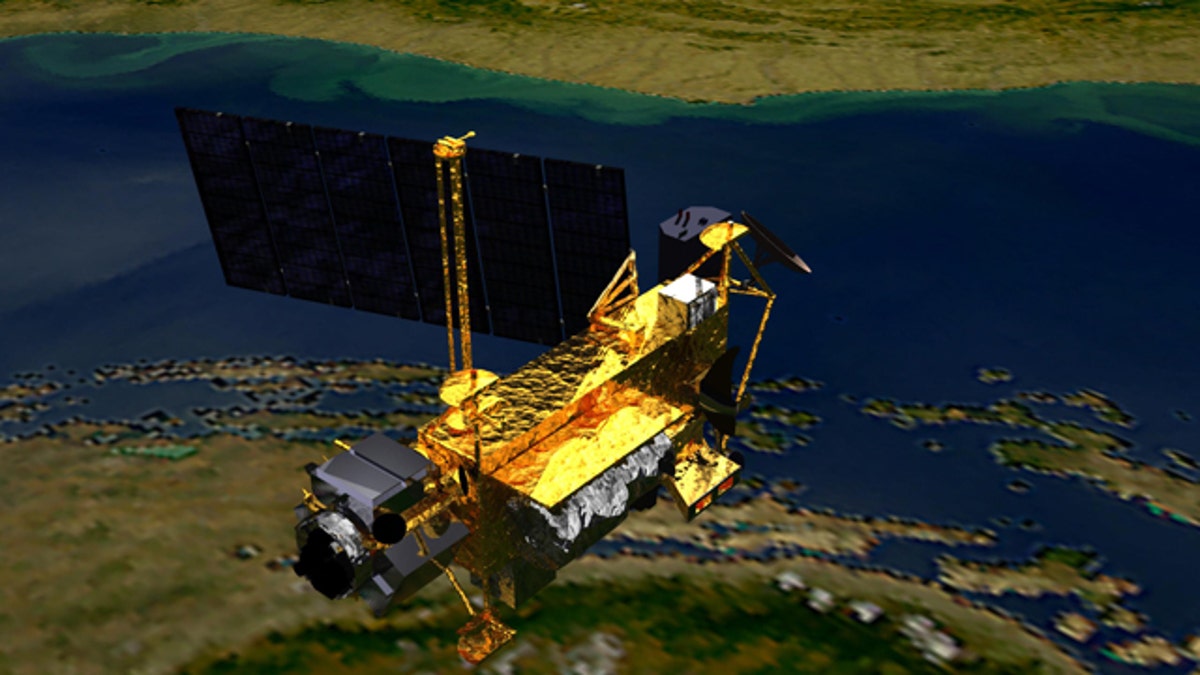
An artist's concept of the Upper Atmosphere Research Satellite (UARS) satellite in space. The 6 1/2-ton satellite was deployed from space shuttle Discovery in 1991 and decommissioned in December 2005. (NASA)
Update: NASA's dead six-ton satellite fell to Earth early Saturday morning somewhere over the vast Pacific Ocean, and the tracker below has been disabled. See FoxNews.com for the latest news on the satellite.
Friday night or early Saturday morning, the sky will actually be falling.
A defunct NASA atmosphere-monitoring satellite the size of a small bus is set to plunge to Earth somewhere between Friday and Saturday -- and the space agency's scientists say there's no way to precisely determine where it will crash, be it Africa or America, the Pacific Ocean or Pacific Heights.
But thanks to a neat widget built exclusively for FoxNews.com by the satellite-tracking website N2YO.com, you can watch the UARS satellite as it courses through the heavens -- see the embedded module below.
Pinpointing where and when hurtling space debris will strike is an imprecise science. To calculate the orbit, N2YO.com runs information from the U.S. Air Force Space Command through a series of algorithms, and overlays it on mapping data from Google.
Not that citizens need to take cover. The satellite will break into pieces, and NASA put the chances that somebody somewhere will get hurt at just 1-in-3,200 -- low enough that some people are making a game of the whole thing.
One Irish company is even allowing people to gamble on the crash site. Paddy Power, Ireland's largest bookmaker, has placed the odds that the satellite will crash in the Pacific Ocean at 8/11, followed by the Atlantic at 2/1.
“This is an absolute lottery," a spokesman for the site said. "It really could land anywhere, but I think it would be best for everyone if the satellite went for a dip.”
As far as anyone knows, falling space debris has never injured anyone -- although one woman came dangerously close. Nor has significant property damage been reported. That's because most of the planet is covered in water and there are vast regions of empty land.
If you do come across what you suspect is a satellite piece, NASA doesn't want you to pick it up. The space agency says there are no toxic chemicals present, but there could be sharp edges. Also, it's government property. It's against the law to keep it as a souvenir or sell it on eBay. NASA's advice is to report it to the police.
The 20-year-old research satellite is expected to break into more than 100 pieces as it enters the atmosphere, most of it burning up. Twenty-six of the heaviest metal parts are expected to reach Earth, the biggest chunk weighing about 300 pounds (136 kilograms). The debris could be scattered over an area about 500 miles (800 kilometers) long.
Jonathan McDowell, for one, isn't worried. He is in the potential strike zone -- along with most of the world's 7 billion citizens. McDowell is with the Harvard-Smithsonian Center for Astrophysics in Cambridge, Massachusetts.
"There's stuff that's heavy that falls out of the sky almost every year," McDowell says. So far this year, he noted, two massive Russian rocket stages have taken the plunge.
As for the odds of the satellite hitting someone, "it's a small chance. We take much bigger chances all the time in our lives," McDowell says. "So I'm not putting my tin helmet on or hiding under a rock."
Due to heavy demand, the module below -- built exclusively for FoxNews.com by N2YO.com -- may take several minutes to load.
All told, 1,200 pounds (544 kilograms) of wreckage is expected to smack down -- the heaviest pieces made of titanium, stainless steel or beryllium. That represents just one-tenth the mass of the satellite, which stretches 35 feet (10.7 meters) long and 15 feet (4.6 meters) in diameter.
The strike zone straddles all points between latitudes 57 degrees north and 57 degrees south. That's as far north as Edmonton and Alberta, Canada, and Aberdeen, Scotland, and as far south as Cape Horn, the southernmost tip of South America. Nearly every continent Antarctica is in the crosshairs, even the U.S. NASA ruled out impact in North America a few days ago; Friday the space agency changed its mind.
Back when UARS, the Upper Atmosphere Research Satellite, was launched to study the ozone layer in 1991, NASA didn't always pay attention to the "what goes up must come down" rule. Nowadays, satellites must be designed either to burn up on re-entering the atmosphere or to have enough fuel to be steered into a watery grave or up into a higher, long-term orbit.
The $740 million UARS was decommissioned in 2005, after NASA lowered its orbit with the little remaining fuel on board. NASA didn't want to keep it up longer than necessary, for fear of a collision or an exploding fuel tank, either of which would have left a lot of space litter.
If it happens in darkness, it should be visible.
"If someone is lucky enough to be near the re-entry at nighttime, they'll get quite a show," says Matney, who works at Johnson Space Center in Houston, also in the potential strike zone.
Space junk in general is on the rise, much of it destroyed or broken satellites and chunks of used rockets. More than 20,000 manmade objects at least 4 inches (10.2 centimeters) in diameter are being tracked in orbit.
It's mostly a threat to astronauts in space, rather than people on Earth. In June, the six residents of the International Space Station took shelter in their docked Soyuz lifeboats because of passing debris. The unidentified object came within 1,100 feet (335.2 meters) of the complex, the closest call yet.
The Associated Press contributed to this report.




















